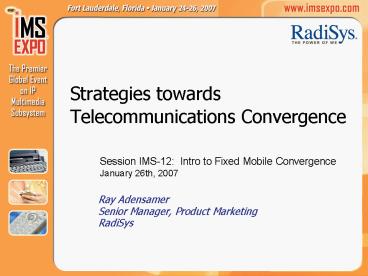Strategies towards Telecommunications Convergence - PowerPoint PPT Presentation
Title:
Strategies towards Telecommunications Convergence
Description:
Television (Video on Demand or regular broadcasts) and ... (MPLS), to transmit delay-sensitive packets with higher priority and dedicated capacity. ... – PowerPoint PPT presentation
Number of Views:49
Avg rating:3.0/5.0
Title: Strategies towards Telecommunications Convergence
1
Strategies towardsTelecommunications Convergence
Session IMS-12 Intro to Fixed Mobile
ConvergenceJanuary 26th, 2007
- Ray Adensamer
- Senior Manager, Product Marketing
- RadiSys
2
Topics
- Common Definitions of Telecommunications
Convergence - Strategies towards Telecommunications Convergence
- Core Network Convergence
- Access Network Convergence
- Service Delivery Convergence
- Hardware Platform Convergence
- Conclusions
3
Fixed Mobile Convergence
- A clear trend is emerging in the form of FMC - A
fixed and mobile telephony convergence. The aim
is to provide both services with a single phone,
which could switch between networks ad
hoc1.Example BT Fusion in UK
Source BT website
1. From www.wikipedia.com (January, 2007)
4
Triple Play
- Triple Play is a marketing term for the
provisioning of the three services over a single
broadband connection1. - High-speed Internet,
- Television (Video on Demand or regular
broadcasts) and - Telephone service over a single broadband
connection. - Plus. Wireless Services gives you a Quadruple
Play - Triple Play services are offered by
- cable television operators
- telecommunication operators.
- Triple Play focuses on a combined business model
rather than on solving technical issues or a
common standard.
This presentation will explore strategies
towards achieving telecom convergence
1. From www.wikipedia.com (January, 2007)
5
Technical Requirements for Telecommunications
Convergence
ConvergenceBarriers
ConvergenceRequirement
MultipleTransport
Common Transport
Inconsistent service delivery dependent on device
and access technology
Ubiquitous service delivery to any device using
any access network
Multiple Service Platforms
Unified Services Architecture
Incompatible, ProprietaryPlatform Technologies
Common, Reusable Platform Technology
6
Internet ProtocolThe Transport Network for
Convergence
- Internet Protocol (IP) is a packet-based
protocol. - Packets take different routes through the
network, and can arrive at different times. - Higher traffic increases network delays.
Source BT website
- Different services have different tolerance to
network delays - Network delays are tolerable for data
services (e.g. file transfers, email, or music
downloads). - However, interactive voice and video services
require real-time response. - Optimizing IP network design is important for
converged IP services. - The generic Internet has limited (if any) ability
to ascertain voice and video packets, hence
quality varies signficantly. - Carrier IP networks improve use additional
techniques, including using Multi Path Label
Switching (MPLS), to transmit delay-sensitive
packets with higher priority and dedicated
capacity.
7
Example BT 21st Century NetworkConvergence to
IP/MPLS network
Source BT 21CN website
8
Access Convergence inIMS Architecture
- Telecommunications services are delivered today
over a variety of access network technology
Transport Layer
Internet
2G Wireless
3G Wireless
Access Layer
Cable
DSL
WLAN
PSTN
9
Voice Services Traditional Deployment Approach
IVR
MessagingSolution
AnnouncementServers
ConferencingBridge
PrepaidServices
Class 5Switch
SpeechServices
Legacy TDM Network
- Services delivered as stand-alone Service Nodes
- Each Service Nodes often has their own
- Proprietary architecture
- Management systems and service databases
- Often tied to a access network subset
- Resulting characteristics and operational
limitations - Multiple systems and databases to manage
- Voice only -gt complex interworking with IP-based
data services - New service introduction complex and slow
10
Service Decomposition The first step towards
convergence
Class 5Softswitch
Messaging Software
IVRSoftware
Speech PortalSoftware
PrepaidSoftware
Conferencing Software
SIP
- Service Nodes decomposed into
- Application logic and
- Media processing.
- Application logic executes on off-the-shelf
servers. - Media processing is shared across many services.
- Interconnection through open standards-based
interfaces.
Common Infrastructure
MultimediaResourceFunctionProcessor(MRFP)
SIP
RTP
IP/MPLS Backbone
Media /Signalling Gateway
TDM
SS7
Legacy TDM Networks
11
Service Convergence inIMS Architecture
Application Servers (AS)
Application Layer
Control Layer
MRF
MultimediaResourceFunctionProcessor(MRFP)
Transport Layer
IP/MPLS TransportNetwork
Internet
Access Convergence to IMS Core Network
2G Wireless
3G Wireless
Access Layer
Cable
DSL
WLAN
PSTN
12
Functional Decomposition Application Servers vs
MRFP
Application Logic Application Signaling Subscriber
Web Interface
Application Server(AS)
SIP
S-CSCF
SIP
SIP
SIP
MRFC
Playing Tones and Announcements Digit Detection
and Generation Record and Playback Bridging and
Mixing Speech Recognition / Text to
Speech Transcoding
H.248 / SIP
Voice Videoover IP (RTP)
MultimediaResourceFunctionProcessor(MRFP)
13
IMS Services reusing Multimedia Processing
Functions
Multimedia Processing Functions of anIP Media
Server (MRFP)
IMS Services
14
AdvancedTCA (ATCA) Common Reusable Platform
- ATCA is a hardware platform specification for
telecom equipment manufacturers. - Enables manufacturers to design plug-compatible
equipment and components that work together.
- Provisionable ATCA Cards for
- Network Processing,
- Digital Signal Processing (DSP),
- Data Processing,
- Switching,
- Storage
- etc.
Common ATCA Hardware Chassis
Reusable Platform Provisionable For
ManyTelecommunication Applications
- OS and
- System S/W
- High Availability
- Platform Management
- Security
- etc.
15
ATCA in IMS Architectures
Reusable ATCA Platforms
Vendor IMS ApplicationSoftware
Cost-Efficient IMS DeploymentUsing Common
ATCA-based Infrastructure
16
Strategies for Telecommunications Convergence
ConvergenceBarriers
ConvergenceRequirement
MultipleTransport
Common Transport
Inconsistent service delivery dependent on device
and access technology
Ubiquitous service delivery to any device using
any access network
Multiple Service Platforms
Unified Services Architecture
Incompatible, ProprietaryPlatform Technologies
Common, Reusable Platform Technology
17
Conclusions
- Convergence often described as business models
and end-device experience - However, to achieve convergence requires
rethinking service delivery in the core network - Strategies towards Telecommunications
Convergence - Core Network Convergence
- Everything over IP (Internet Protocol)
- Access Network Convergence
- Mapping any Access/Device to IP using IMS
- Service Delivery Convergence
- Decomposed Services Approach for Voice/Video over
IP - Mapping Any Service to IP using IMS
- Hardware Platform Convergence
- ATCA Platforms provide flexibility for any IMS
application
18
Thank you
- RadiSys is a leader in application-enabling
technologies for telecommunication and IMS
equipment vendorsand their service provider
customers
RadiSys Promentum ATCA Platforms
Ray AdensamerSenior Manager, Product
MarketingRadiSys Incorporatedray.adensamer_at_radis
ys.com1 (604) 918-6318
RadiSysConvedia Media Servers































